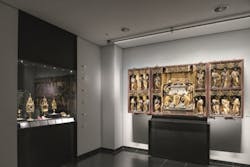Stringent conservation goals mandated LED lighting including controls that not only save energy but minimize the exposure of historic works to light.
Zumtobel has announced an LED-based retrofit of the Aachen Cathedral Treasury lighting aimed to minimize energy usage while improving the quality of the museum experience and ensuring minimal damage to precious works that might be caused by light. The project is projected to deliver 70,000 kWh annually in energy savings along with reducing the need for air conditioning for a net benefit of EUR 20,000 ($22,355).
The historic German cathedral, once known as the Church of Maria, is the burial place of Charlemagne who resided for periods in Aachen and was responsible for beginning construction on the cathedral. Roman-German kings were crowned in the cathedral from 936 AD to 1531 AD and some exhibits in the Aachen Cathedral Treasury date to that period. The history resulted in the Aachen Cathedral becoming the first UNESCO World Heritage Site in Germany back in 1978.
The municipal Plan Ing Aachen electrical planning team lead by Ralf Wolters was charged with managing the retrofit project for the museum lighting. The team was charged to minimize ambient light and eliminate all daylight from the museum, following the latest principles on conservation of historic exhibits.
The challenge essentially came down to minimizing the ambient light and placing the light utilized precisely where it was needed. "In a series of meticulous tests, each light source was carefully adjusted with the help of the curator," said Wolters. "The final lighting scene was saved digitally and can now be modified by the curators to create new lighting scenarios."
Three different Zumtobel product families were used to deliver ambient lighting — adjustable spotlights in the Supersystem and Arcos families and Panos Infinty downlights. All of the products are dimmable, and the Supersystem and Panos products installed feature a CRI over 90.
All of the museum lighting mentioned above was intended for ambient lighting, albeit targeted ambient lighting. The Treasury also had existing fiber optics that had been installed to light the historic objects in settings like display cases. Those optics were previously driven by halogen sources. Now custom LED light engines drive the light through the fiber optics.
Still, despite the energy-efficient sources used throughout the museum, adaptive controls were mandated in the project. The mandate for controls was as much about protecting the works as about energy savings. Indeed, occupancy sensors throughout the museum provide fine-grain control to dim lights in areas where no visitors are present.
"We are very grateful for the excellent cooperation on the part of all participating companies," said cathedral architect Helmut Maintz enthusiastically. "By taking into account the conservational and energy-efficiency aspects, we have been able to blend the past and the future in its most beautiful form, preserving the Aachen Cathedral Treasury for posterity."
LED lighting is increasingly being used both indoors and outdoors in UNESCO World Heritage Sites. In addition to energy savings, small-form-factor solid-state lighting (SSL) products are easy to conceal, and have modest power needs, meaning no new wires are required. For example, we have covered the Durham Castle in England, the Grand Place in Belgium, the Rabat walls in Morocco, and many others.

Maury Wright | Editor in Chief
Maury Wright is an electronics engineer turned technology journalist, who has focused specifically on the LED & Lighting industry for the past decade. Wright first wrote for LEDs Magazine as a contractor in 2010, and took over as Editor-in-Chief in 2012. He has broad experience in technology areas ranging from microprocessors to digital media to wireless networks that he gained over 30 years in the trade press. Wright has experience running global editorial operations, such as during his tenure as worldwide editorial director of EDN Magazine, and has been instrumental in launching publication websites going back to the earliest days of the Internet. Wright has won numerous industry awards, including multiple ASBPE national awards for B2B journalism excellence, and has received finalist recognition for LEDs Magazine in the FOLIO Eddie Awards. He received a BS in electrical engineering from Auburn University.





